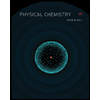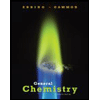
Chemistry, The Central Science, Volume 1, Custom For Houston Community College
19th Edition
ISBN: 9781323850206
Author: Lemay, Bursten Brown, Woodward Murphy, Lufaso Stoltzfus
Publisher: Pearson Higher Ed
expand_more
expand_more
format_list_bulleted
Textbook Question
Chapter 19, Problem 14E
- Can endothermic
chemical reaction be spontaneous? - Can a process be spontaneous at one temperature and no spontaneous at a different temperature?
- Water can be decomposed to form hydrogen and oxygen, and oxygen can be recombined to form water. Does this mean that the process es are
thermodynamically reversible? - Does the amount of work that a system can do on its surroundings depend on the path of the process?
Expert Solution & Answer
Want to see the full answer?
Check out a sample textbook solution
Students have asked these similar questions
Pls help me on this q.
Given the elementary reactions in an aqueous medium with an ionic strength of 0.001:1) CH3Br + OH- → CH3OH + Br-2) ClCH2COO- + OH- → HOCH2COO- + Cl-3) [Co(NH3)5Br]2+ + NO2- →[Co(NH3)5NO2]2+ + Br-If the ionic strength is decreased, 1) k will not change; 2) k will decrease; and 3) k will increase. Is this correct?
Relate zero ionic strength and infinite dilution limit.
Chapter 19 Solutions
Chemistry, The Central Science, Volume 1, Custom For Houston Community College
Ch. 19.1 - The process of iron being oxidized to make iron...Ch. 19.1 - At 1 atm pressure, CO2(s) sublimes at 78oC. Is...Ch. 19.2 - Prob. 19.2.1PECh. 19.2 - Prob. 19.2.2PECh. 19.3 - Prob. 19.3.1PECh. 19.3 - Prob. 19.3.2PECh. 19.3 - Prob. 19.4.1PECh. 19.3 - Prob. 19.4.2PECh. 19.4 - Prob. 19.5.1PECh. 19.4 - Using the standard molar entropies in Appendix C,...
Ch. 19.5 - Which of these statements is true? All spontaneous...Ch. 19.5 - Prob. 19.6.2PECh. 19.5 - Prob. 19.7.1PECh. 19.5 - Prob. 19.7.2PECh. 19.5 - Prob. 19.8.1PECh. 19.5 - Prob. 19.8.2PECh. 19.6 - What is the temperature above which the Haber...Ch. 19.6 - Prob. 19.9.2PECh. 19.7 - Prob. 19.10.1PECh. 19.7 - Prob. 19.10.2PECh. 19.7 - Prob. 19.11.1PECh. 19.7 - Prob. 19.11.2PECh. 19.7 - Prob. 19.12.1PECh. 19.7 - Prob. 19.12.2PECh. 19 - Prob. 1DECh. 19 - Prob. 1ECh. 19 - As shown here, one type of computer keyboard...Ch. 19 - 19.3
a. What are the signs of ΔS and ΔH for the...Ch. 19 - Predict the signs of H and S for this reaction....Ch. 19 - The accompanying diagram shows how entropy varies...Ch. 19 - Prob. 6ECh. 19 - The accompanying diagram shows how H (red line)...Ch. 19 - Prob. 8ECh. 19 - Prob. 9ECh. 19 - Prob. 10ECh. 19 - Prob. 11ECh. 19 - Prob. 12ECh. 19 - Prob. 13ECh. 19 - Can endothermic chemical reaction be spontaneous?...Ch. 19 - Prob. 15ECh. 19 - Prob. 16ECh. 19 - Prob. 17ECh. 19 - Prob. 18ECh. 19 - Prob. 19ECh. 19 - Prob. 20ECh. 19 - Prob. 21ECh. 19 - Prob. 22ECh. 19 - Prob. 23ECh. 19 - Prob. 24ECh. 19 - Prob. 25ECh. 19 - Prob. 26ECh. 19 - Prob. 27ECh. 19 - Prob. 28ECh. 19 - Prob. 29ECh. 19 - Prob. 30ECh. 19 - Prob. 31ECh. 19 - Using the heat of vaporization in Appendix B,...Ch. 19 - Prob. 33ECh. 19 - Prob. 34ECh. 19 - Prob. 35ECh. 19 - Prob. 36ECh. 19 - Prob. 37ECh. 19 - Prob. 38ECh. 19 - For each of the following pairs, predict which...Ch. 19 - For each of the following pairs, predict which...Ch. 19 - Predict the sign of the entropy change of the...Ch. 19 - Prob. 42ECh. 19 - Prob. 43ECh. 19 - 19.44 Propanol (C3H7OH) melts at – 126.5 o C and...Ch. 19 - Prob. 45ECh. 19 - Prob. 46ECh. 19 - Prob. 47ECh. 19 - Prob. 48ECh. 19 - Prob. 49ECh. 19 - Prob. 50ECh. 19 - Using So values from Appendix C, calculate So...Ch. 19 - Calculate So values for the following reactions by...Ch. 19 - Prob. 53ECh. 19 - Prob. 54ECh. 19 - For a certain chemical reaction, Ho = -35.4 kJ and...Ch. 19 - A certain reaction has Ho = +23.7.kJ and So = +...Ch. 19 - Using data in Appendix C, calculate Ho, So, and Go...Ch. 19 - Prob. 58ECh. 19 - Prob. 59ECh. 19 - Prob. 60ECh. 19 - Prob. 61ECh. 19 - Prob. 62ECh. 19 - Prob. 63ECh. 19 - Prob. 64ECh. 19 - Prob. 65ECh. 19 - Prob. 66ECh. 19 - Prob. 67ECh. 19 - Prob. 68ECh. 19 - Prob. 69ECh. 19 - Prob. 70ECh. 19 - a. Use data in Appendix c to estimate the boiling...Ch. 19 - Prob. 72ECh. 19 - Prob. 73ECh. 19 - Prob. 74ECh. 19 - Prob. 75ECh. 19 - Prob. 76ECh. 19 - Prob. 77ECh. 19 - 19.78 Consider the reaction 3CH4(g) C3H8(g) ...Ch. 19 - Use data from Appendix C to calculate the...Ch. 19 - Prob. 80ECh. 19 - Prob. 81ECh. 19 - Prob. 82ECh. 19 - Prob. 83ECh. 19 - Prob. 84ECh. 19 - Prob. 85AECh. 19 - Prob. 86AECh. 19 - Prob. 87AECh. 19 - Prob. 88AECh. 19 - Prob. 89AECh. 19 - Prob. 90AECh. 19 - Prob. 91AECh. 19 - Prob. 92AECh. 19 - Prob. 93AECh. 19 - Prob. 94AECh. 19 - Prob. 95AECh. 19 - Prob. 96AECh. 19 - Prob. 97AECh. 19 - Prob. 98AECh. 19 - Prob. 99AECh. 19 - Prob. 100AECh. 19 - Prob. 101AECh. 19 - Prob. 102AECh. 19 - Most liquids follow Trouton’s rule (see Exercise...Ch. 19 - In chemical kinetics, the entropy of activation is...Ch. 19 - Prob. 105IECh. 19 - Prob. 106IECh. 19 - Prob. 107IECh. 19 - Prob. 108IECh. 19 - The following data compare the standard enthalpies...Ch. 19 - Prob. 110IECh. 19 - Prob. 111IECh. 19 - Prob. 112IE
Knowledge Booster
Learn more about
Need a deep-dive on the concept behind this application? Look no further. Learn more about this topic, chemistry and related others by exploring similar questions and additional content below.Similar questions
- The photolysis of H3C–N=N–C2H5 involves the breaking of the single bonds shown. According to this, in addition to N2, what products would be obtained primarily if the reaction were carried out in the gas phase or in solution in an inert solvent?arrow_forwardGiven a keto-enol tautomerization reaction, which is greatly influenced by the type of solvent, indicate which of the following solvent properties cannot be considered a "solvent effect"?(A) Dielectric constant(B) Polarity(C) Hydrogen bonding capacity(D) Temperaturearrow_forwardIn solution reactions, what does "solvent effect" mean?arrow_forward
- How to solvearrow_forwardIndicate the concentration and ionic strength ranges to which the Debye-Huckel equation can be applied. And the Davies equation?arrow_forwardIf the ionic strength (I) of a solution is very low, the Debye-Huckel equation is used. If I is higher, the Davies equation is used. What is the correct value for I to use one or the other?arrow_forward
- In both the Debye-Huckel equation and the Davies equation, there is a constant A. I see that sometimes it appears as 0.51 and other times as 1.02. Explain why one or the other value is used.arrow_forwardThe two equations are forms of the Davies equation, used in thermodynamics for activity coefficients: ال log Y₁ = -Az² - 0,31 log = Az² - 0,31 1 + √Ĩ 1 + √√ k These equations are consistent and imply that Yi = Is this last equation correct? karrow_forwardThe two equations are forms of the Davies equation, used in thermodynamics for activity coefficients: ال log Y₁ = -Az² - 0,31 log = Az² - 0,31 1 + √Ĩ 1 + √√ k These equations are consistent and imply that Yi = Is this last equation correct? karrow_forward
- For the Davies equation, both expressions are correct: log Y₁ = -Az² √i - 0,31 1 + √ k log- = Az - 0,31 k 1 + √Ĩarrow_forwardk In Davies' equation log y₁ = log- log y₁ = log | = -Az² + ✓// k A is a constant that always equals 1.02. Correct? - 0,31arrow_forwardIndicate whether the equality is true Yi How is it obtained? k%arrow_forward
arrow_back_ios
SEE MORE QUESTIONS
arrow_forward_ios
Recommended textbooks for you
- Chemistry: Matter and ChangeChemistryISBN:9780078746376Author:Dinah Zike, Laurel Dingrando, Nicholas Hainen, Cheryl WistromPublisher:Glencoe/McGraw-Hill School Pub Co
 Physical ChemistryChemistryISBN:9781133958437Author:Ball, David W. (david Warren), BAER, TomasPublisher:Wadsworth Cengage Learning,
Physical ChemistryChemistryISBN:9781133958437Author:Ball, David W. (david Warren), BAER, TomasPublisher:Wadsworth Cengage Learning, General Chemistry - Standalone book (MindTap Cour...ChemistryISBN:9781305580343Author:Steven D. Gammon, Ebbing, Darrell Ebbing, Steven D., Darrell; Gammon, Darrell Ebbing; Steven D. Gammon, Darrell D.; Gammon, Ebbing; Steven D. Gammon; DarrellPublisher:Cengage Learning
General Chemistry - Standalone book (MindTap Cour...ChemistryISBN:9781305580343Author:Steven D. Gammon, Ebbing, Darrell Ebbing, Steven D., Darrell; Gammon, Darrell Ebbing; Steven D. Gammon, Darrell D.; Gammon, Ebbing; Steven D. Gammon; DarrellPublisher:Cengage Learning  Chemistry: Principles and PracticeChemistryISBN:9780534420123Author:Daniel L. Reger, Scott R. Goode, David W. Ball, Edward MercerPublisher:Cengage Learning
Chemistry: Principles and PracticeChemistryISBN:9780534420123Author:Daniel L. Reger, Scott R. Goode, David W. Ball, Edward MercerPublisher:Cengage Learning World of ChemistryChemistryISBN:9780618562763Author:Steven S. ZumdahlPublisher:Houghton Mifflin College Div
World of ChemistryChemistryISBN:9780618562763Author:Steven S. ZumdahlPublisher:Houghton Mifflin College Div Chemistry for Engineering StudentsChemistryISBN:9781337398909Author:Lawrence S. Brown, Tom HolmePublisher:Cengage Learning
Chemistry for Engineering StudentsChemistryISBN:9781337398909Author:Lawrence S. Brown, Tom HolmePublisher:Cengage Learning

Chemistry: Matter and Change
Chemistry
ISBN:9780078746376
Author:Dinah Zike, Laurel Dingrando, Nicholas Hainen, Cheryl Wistrom
Publisher:Glencoe/McGraw-Hill School Pub Co

Physical Chemistry
Chemistry
ISBN:9781133958437
Author:Ball, David W. (david Warren), BAER, Tomas
Publisher:Wadsworth Cengage Learning,

General Chemistry - Standalone book (MindTap Cour...
Chemistry
ISBN:9781305580343
Author:Steven D. Gammon, Ebbing, Darrell Ebbing, Steven D., Darrell; Gammon, Darrell Ebbing; Steven D. Gammon, Darrell D.; Gammon, Ebbing; Steven D. Gammon; Darrell
Publisher:Cengage Learning

Chemistry: Principles and Practice
Chemistry
ISBN:9780534420123
Author:Daniel L. Reger, Scott R. Goode, David W. Ball, Edward Mercer
Publisher:Cengage Learning

World of Chemistry
Chemistry
ISBN:9780618562763
Author:Steven S. Zumdahl
Publisher:Houghton Mifflin College Div

Chemistry for Engineering Students
Chemistry
ISBN:9781337398909
Author:Lawrence S. Brown, Tom Holme
Publisher:Cengage Learning
The Laws of Thermodynamics, Entropy, and Gibbs Free Energy; Author: Professor Dave Explains;https://www.youtube.com/watch?v=8N1BxHgsoOw;License: Standard YouTube License, CC-BY